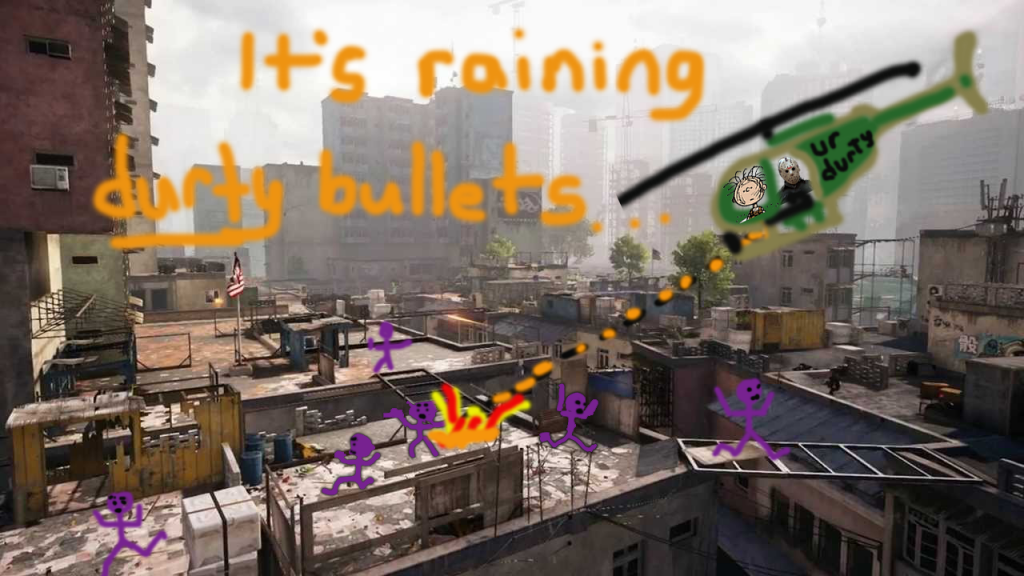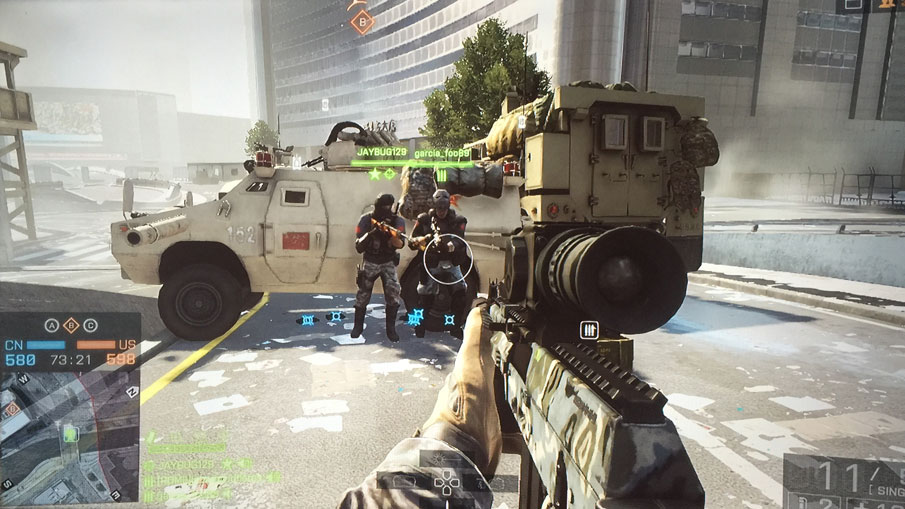durty shows you the future of Whiteout…
Tag Archives: Battlefield 4
Editors Note: Another Historical Moment for the BOOM!

Editor’s Note: The article below represents another historical milestone for the BOOM for numerous reasons. Over the past few months, we have noticed, in our traffic results, a sharp increase in visitors from China, and the Orient in general. While we anticipated a Japanese appreciation for our work, and have translated articles into their language, we did not expect the remarkable response from our video gaming sisters and brothers from the motherlands of China and Vietnam. You are, both, most welcome to the BOOM.
In honor of their extraordinary participation, we have decided to translate some of our future articles into other languages of the East. Our first, is a translation, into Mandarin Chinese, of our most popular series to-date: “The Panopticon in My Bedroom: Parts I & 2.” It is our way of saying “Thank You” for coming to the BOOM, and allowing us to inform and entertain you.

-BOOM
Mandarin Translation of the above:
THE ROOM: An Architectural Theory of the Future Technological Foundations of a VR Universe.
In a recent GAMESPOT article, Strauss Zelnick, the CEO of Take-Two Interactive, encapsulated in a single sentence, the greatest challenge ahead for Virtual Reality. He said, “…there is no market for [an] … entertainment device that requires you to dedicate a room to the activity.” He, then, went on to identify the second major issue, when he jokingly said, “We don’t have a [room] where you stand in a big open space and hold two controllers with something on your head—and not crash into the coffee table. We don’t have that.”
And that my friends, is why Mr. Zelnick, though admittedly not a “gamer,” makes the big bucks.

As progeny of the television-centric home entertainment ecosystem (HEe)[1] we have grown accustomed to staring at moving pictures on walls (see Figure 1), and not moving while we do so. Certainly there are times when movement is appropriate and expected, but in order to fit within the HEe it must be anticipated, and changes made to accommodate the increased need for space and separation. In other words, you need to move “the coffee table” so no one gets injured.
But in most cases, we watch TV, not moving, and, often, reclining. In fact, there have been numerous studies conducted by the manufacturers of video and audio equipment that indicate the best viewing angle, and thus seating position, for the consumer to fully enjoy a, so-called, “immersive,” entertainment experience. VR will eventually demand more.
In this, the first of a two-part series of the BOOM, I examine the problems inherent in the VR experience, as a duplication and augmentation of reality, in the context of spatial dynamics (the ROOM), room orientation, stabilization, and finally, sound presentation. It is around these fundamentals, along with several others, that the foundations of true, cognitive envelopment, necessary to convince our minds we are really somewhere else, may be established.
BOOM Salad 出品:durtyrezkidz, 也称为”TURBO AJ LITTLE BIRD.” 枪林弹雨!
BOOM Salad Presents: BOT RAGE!!!!!
BOOM Salad Proudly Presents: durtyrezkidz, a.k.a “Turbo Aj Little Bird.” The Sky is Falling!
 Rarely does one get an opportunity to witness what happens when total mastery over fundamentals intersects with raw talent. And yet, that is exactly what has happened: lightning has struck the BOOM twice!
Rarely does one get an opportunity to witness what happens when total mastery over fundamentals intersects with raw talent. And yet, that is exactly what has happened: lightning has struck the BOOM twice!
It is with great pride that I announce to our readers, the BOOM’s latest sponsee: durtyrezkidz, a.k.a. “Turbo AJ Little Bird.”
He is simply the BEST Little Bird pilot we have ever seen, a remarkable statement considering our past experience. Come watch and be amazed…the sky is falling.
La Violencia Extraordinaria de los VideoJuegos, Parte III: “BOOM Salad solicita el FIN DE LA ESTIGMITIZACIÓN Y MARGINALIZACION DE LOS VIDEOJUEGOS CON REPRESENTACIONES VIOLENTAS Y AQUELLOS QUE LOS JUEGAN.”
https://youtu.be/z-Po7QLx1NE
Desde junio de este año, BOOM Salad ha estado rentando sus propios “servidores”[1] para el videojuego violento, Battlefield 4.[2] Esto quiere decir que por los últimos meses hemos pagado una compañía por el privilegio de manejar y mantener nuestro propio ámbito multijugador online para el juego. Prácticamente cualquier persona en cualquier país que posea Battlefield 4 y que tenga una conexión internet de alta velocidad puede jugar en nuestros servidores.
Durante los últimos 120 días que nuestro servido Playstation 3 (PS3) ha estado disponible y accesible al público, hemos jugado con y contra jugadores de una gran variedad de grupos de edad, de cultura, de etnia y de género. Esto nos ha permitido una oportunidad única de observar y participar directamente en lo que es conocido como los masivos juegos multijugador mundiales o Massively Multiplayer Online Gaming (MMO, véase Figura 1).

Ejemplos importantes de este género incluyen World of Warcraft y Minecraft. El juego Minecraft se ha devuelto en un fenómeno cultural mundial comparable con la manía del juego Pacman de los primeros años de 1980.[3] Más que un simple laberinto en que la meta nunca cambia ni llega a ser más que el consumo de puntos, frutas y fantasmas, es perfectamente posible que Minecraft sea uno de los juegos más sutilmente complejo que jamás se ha visto.
Como su anónimo, es mejor pensar en el juego como que tiene “niveles” de complejidad. Cada nivel ofrece muchas oportunidades de interacción empática y pro-social con otros jugadores online. El número de jugadores que pueden participar en una sola sesión depende en el plataforma, pero para las consolas como Playstation 4 (PS4), lo máximo es ocho a la vez.[4] En las conversaciones que hemos tenido con los jugadores menores de Minecraft,[5] nos dijeron una y otra vez que el motivo principal era construir cosas con sus amigos. La frase “construir cosas” no quiere decir espadas, bombas y otras armas aunque eso puede ser. A los jóvenes con quienes hemos hablado les interesaba mucho más construir castillos con recámaras adornadas y habitaciones subterráneas (véase el video de abajo). Sin embargo, ya que este juego incluye imágenes violentas en sus escenarios de batalla (que se puede activar o desactivar), eso se equivale con otros llamados “videojuegos violentos” como Battlefield 4 y por consecuencia se les considera “peligroso [para la sociedad],” por muchos de la comunidad médica. [6]
En las Ediciones I y II de esta serie hemos demostrado cómo los argumentos en contra los videojuegos con representaciones violentas son basados en una llamada “conexión” entre la violencia del mundo real y la de los videojuegos. Esta “conexión” es observada en aquellos que juegan los videojuegos violentos, según los resultados de varias investigaciones médicas, [7] por la disminución cuantificable de la función cognitiva dentro de las áreas conocidas como reguladores e influencias en el comportamiento agresivo y violento. Si estas conclusiones son exactas o no, [8] el hecho es que no ofrecen una respuesta suficiente a la pregunta más importante de todas (algo que BOOM Salad ha procurado contestar desde nuestra primera edición [9]): ¿Por qué la gente juega estos juegos en primer lugar?
BOOM Salad Thanks King-Dylan666: The Paganini of the First-Person-Shooter.

At the end of last fall, BOOM Salad entered into an historic agreement to become the first to sponsor the Battlefield 4 player known as KING-DYLAN666.[1] Since that time, we have been honored to reveal to the world, via this website, his near inhuman playing skills on the battlefield. Time and again, in video after video (see below), the KING has demonstrated conclusively that he is one of the best in the business. He is a machine, a true 21st century gaming freak of nature, and yet, some in the online gaming world have sought to undermine his place amongst the elite, by criticizing the amount of time the KING has played the game for which he has become well-known.

According to his Battlelog profile, KING-DYLAN666 has spent a total of 9,320 hours playing Battlefield 4 (PS3 and PS4 combined). If one assumes he began playing on the date of the game’s release in 2013, that would mean he has played, on average, more than 10 hours a day, for nearly two and a half years!
But I know what some of you are thinking, because, for the past six months, we’ve heard it all:
“What a loser!”
“Damn Daniel! That man needs to get a life!”
“I bet he’s a virgin.”
Naturally it is hard for some to fathom the kind of dedication that the KING has put into an activity that continues to be miscategorized by society as a form of casual entertainment. By this I mean that the criticisms leveled at KING-DYLAN for the amount of time he has spent perfecting his skill, reveal an outdated view of video gaming that fails to recognize its increasing complexity as a practice. Moreover, such statements also demonstrate a disappreciation of the physical ability required to achieve the level of dominance exhibited by the KING.
“A estranha violência de Video Games, Parte III: “BOOM Salad Cria Um Fim para a estigmatização, marginalização e a e a deturpação de Jogos de Vídeo Game Violentos e os Jogadores que amam jogá-los.”
Desde Junho desse ano, BOOM Salad vêm alugando os seus próprios “servidores” para o jogo violento, Battlefield 4. Isso significa que, esses meses passados, nós pagamos a uma companhia pelo privilégio em poder manter o nosso próprio ambiente de multijogadores online no jogo. Virtualmente qualquer pessoa no mundo que tem o jogo Battlefield 4, e que tem acesso à internet rápida e de boa qualidade, poderão jogar com os nossos próprios servidores.

Nos 120 dias em que o nosso servidor de Playstation 3 (PS3) tinha sido operacional, e aberto ao público, nós temos jogado com e contra uma variedade de idades, culturas, etnicidade, e gêneros. Isso tem custado a nós uma oportunidade única para observar e participar, em primeira mão ao, no que é conhecido mundialmente, um jogo multijogador ou Massivamente Multijogador.
Exemplos importantes desse gênero incluem World of Warcraft ou Minecraft. O jogo Minecraft, está tornando-se um fenômeno global e cultural, alcançando a sensação do jogo Pacman dos anos 80. Mais que um simples labirinto em que o objetivo nunca muda, e que nunca vai além do consumo de bolinhas, frutas e fantasmas, Minecraft pode muito bem ser um dos jogos mais sutilmente complexo que já foi inventado.
Como o nome já diz, o melhor a pensar é de um jogo que tenha camadas de complexidade. Cada camada fornece diversas oportunidades de socialização e interação empática com outros jogadores online. O número de jogadores que poderão participar em uma sessão individual interativamente depende da plataforma, mas para os consoles como o Playstation 4 (PS4), o máximo seria oito de cada vez.
Em conversas que nós tivemos com jogadores jovens de Minecraft, eles nos falaram que o motivo principal para o qual eles estarem jogando era para construir coisas com os amigos. E por falar em “construir coisas”, nós não queremos dizer que são espadas e bombas e outras armas, apesar de que isso tudo é possível. As crianças que nós falamos estavam mais interessadas em construir castelos com quartos com ornamentos incríveis e moradias subterrâneas (assista o vídeo abaixo). E ainda porque o jogo inclui representações de violência nas batalhas (os quais podem ser ligados ou desligados), ele é equipado com o tão chamado “jogos de vídeo game-violentos”, como Battlefield 4, e é portanto considerado por muitos dentro da comunidade de medicina por ser “prejudicial [à sociedade].”
Nas partes 1 e 2 dessa série, nós demonstramos como os argumentos de vídeo games com representações violentas baseiam-se em um “link” entre a violência do mundo real e violência do jogo de vídeo. Esse “link” é observável, de acordo com vários estudos médicos, em aqueles que jogam jogos violentos, no declínio mensurável na função cognitiva em áreas que são conhecidos como regulamentar e que influenciam o comportamento agressivo e violento. Independente se essas conclusões são exatas ou não, o fato é que eles não fornecem uma resposta satisfatória para a pergunta mais importante de todas, (algo que o BOOM Salad têm se esforçado desde a nossa primeira edição): Por que as pessoas jogam esses jogos em primeiro lugar?
The Uncanny Violence of Video Games, Part III: “BOOM Salad Calls For An End to the Stigmatization, Marginalization, and Misrepresentation of Violent Video Games and the Players that Love To Play Them.”
Since June of this year, BOOM Salad has been renting its own “servers”[1] for the violent video game, Battlefield 4.[2] This means that, for the past several months, we have paid a company for the privilege of managing and maintaining our own online, multiplayer environment for the game. Virtually anyone in the world, who owns Battlefield 4, and has access to a high-speed Internet connection, can play on our servers.

In the 120 days that our Playstation 3 (PS3)server has been operational, and open to the public, we have played with and against a wide variety of age groups, cultures, ethnicities, and genders. This has afforded us a unique opportunity to observe and participate, first-hand, in what’s known as worldwide, multiplayer gaming, or, Massively Multiplayer Online Gaming (MMO, see Figure 1).
Important examples of the genre include World of Warcraft and Minecraft. The game, Minecraft, has become a global, cultural phenomenon, somewhere on par with the Pacman craze of the early-1980’s.[3] But more than just a simple maze in which the goal never changes, and never gets beyond the consumption of dots, fruit, and ghosts, Minecraft may very well be one of the most subtly complex video games ever devised.
Like its namesake, it is best to think of the game as having “layers” of complexity. Each layer provides numerous opportunities for pro-social, empathetic interaction with other players online. The number of players that can participate in a single session interactively depends on the platform, but for consoles like the Playstation 4 (PS4), the maximum is eight at a time.[4]
In conversations we have had with younger players of Minecraft,[5] we were told, time and again, that the primary motive for playing was building things with their friends. And by, “building things,” we don’t mean swords, and bombs, and other weapons, though all that is possible. The children we spoke with were far more interested in building castles with incredibly ornate bedrooms, and underground dwellings (see video below). And yet, because the game includes depictions of violence in its battle play (which can be turned on or off), it is equated with other, so-called “violent-video games,” like Battlefield 4, and is, therefore, considered by many in the medical community to be, “harmful [to society].”[6].
In Parts I and II of this series, we demonstrated how the arguments against video games with violent depictions are based on a so-called, “link,” between real-world violence and video game violence. This “link” is observable, according to various medical studies, [7] in those who play violent video games, in the measurable decline in cognitive function in areas that are known to regulate and influence aggressive and violent behavior. Whether or not these conclusions are accurate, [8] the fact is they do not provide a satisfying answer to the most important question of all, (something BOOM Salad has endeavored to do since our first issue, [9]): Why do people play these games in the first place?